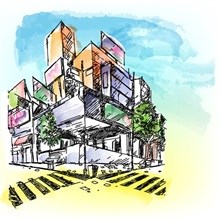
South Africa has a less than favourable economic outlook but the persistence of many business owners to continue purchasing commercial properties is key, says Brett Webb, Head of Specialised Lending Specialised Sales and Commercial Markets at Standard Bank.
"Despite the downturn in the economy and expectations that interest rates will increase further in 2015, the bank's clients are still buying property, but becoming more selective in their purchasing patterns. Notwithstanding this added caution, the bank had, to date in 2014, negotiated 'owner-occupier' transactions that were in line with 2012/2013 figures, and experienced a 44% upsurge," he adds.
Activity in the bank's specialised lending portfolio is concentrated on owner-occupied properties worth a minimum of R5 million and clients with a minimum turnover of R10 million and a maxim turnover of R1.2 billion. The typical property purchase agreement is for a period of 10 years. Buyers typically borrow between 70 to 75% of the property's value; the owner-occupiers equity contributions are driven by factors such as demand for the property etc.
One of the strong factors driving the owner-occupier market is that a combined view is taken on the client and the property to determine the client's level of equity contribution when a purchase is concerned.
"Owner-occupiers are taking a longer-term view of the market and are making property investments only when the stability and potential of their markets and company cash flows have been carefully examined.
"Factors impacting on property purchasing decisions have also been influenced by the rentals being paid in the geographical areas in which businesses operate. There have been instances where, in areas that are less in demand because of their location, rents have remained static or even declined. In others, however, where the location is central and ideal for potential buyers the opposite has been true.
"The major issue presently impacting the sales of commercial properties is the cost base related to municipal rates and energy increases that in many cases have outstripped the growth in rentals. Where rentals have been low, many potential purchasers of buildings have held back from making an investment when viewing energy and rates costs."
"Where businesses are owner-occupied, they have taken advantage of various subsidy schemes on offer to reduce energy costs. Typically, 'greening' their buildings has involved retrofitting lighting systems and obtaining cost-efficient equipment such as electric motors. It is more difficult to achieve these operational savings when premises are rented and the landlord has to shoulder some of the cost burden involved."
"The primary area of activity in the owner-occupier segment during 2014 was Gauteng. In KwaZulu-Natal, the commercial property market is evenly split between investors and owner-occupiers. The Western Cape is fundamentally different with investors rather than owner-occupiers taking the lead on commercial property purchases. A few large investors dominate the Eastern Cape market. This makes entry into the market in the Eastern Cape difficult for smaller owner-occupiers and investors in the region."
In provinces such as Mpumalanga, Northern Cape and the Free State, a shift has occurred with investors, often already owner-occupiers in their own right, taking the lead in diversifying into the rental market. The Mozambique Corridor, where significant government and municipal spend has taken place, has encouraged the growth of business and stimulated activity in the owner-occupier sector.
"The same dynamics apply near the Coega development area in Port Elizabeth, and industrial development zones that have been established in East London in the Eastern Cape, as well as the Dube Trade Port near Durban's King Shaka International Airport.
"What is key to the owner-occupier market now is how new developments and, indeed, redevelopments are impacted on by the availability of infrastructure. Going forward, the pace of developments and where they take place will be influenced by municipal spend on services and access to transport."
"This bodes well for some locations such as Jacobs in Durban. Although this is an ageing industrial area, it is in high demand because of its central location on the outskirts of the CBD to the existing harbour and new harbour developments. Transport costs are also contained, making it an attractive investment for people wishing to construct purpose-built facilities."
"What will continue to drive investments by owner-occupiers is the fundamental difference that exists between landlords and business owners looking for a sound investment. The investor needs to weigh the cost of his purchase or building project against rentals that can be achieved."
"For the owner-occupier, the emphasis is on a business perspective. A location will be evaluated on how it will impact on trading activities and the owner-occupier will be willing to make an investment based on this outlook," Webb concludes.